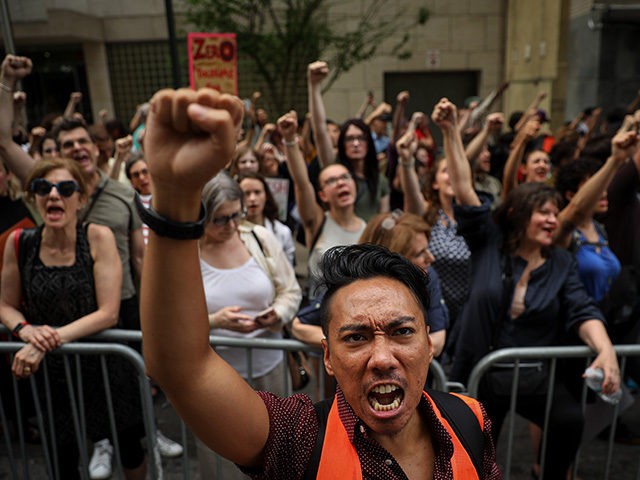Americans are finally winning higher wages because wealthy investors are trying to create more profit-generating jobs in an economy with few unemployed workers, the Washington Post’s editorial board admitted on April 5.
So the government should respond to this rare economic advantage for ordinary Americans by enabling investors and CEOs to hire more foreign workers, according to the editorial board’s opinion in the Washington Post:
This imbalance is giving workers and job seekers tremendous power. Pay is rising at the fastest pace in years, workers are quitting jobs and finding new ones at record levels, hourly employees at companies such as Starbucks and Amazon are starting unions, and companies are offering flexibility and benefits that would have been almost unthinkable pre-pandemic. These are welcome trends.
[…]
Companies are desperate for workers. Millions of legal immigrants want to work in the United States. This shouldn’t be so hard to fix.
The editorial board’s article is headlined: “The U.S. needs more workers. Too bad our legal immigration is a mess.”
The Washington Post is owned by Jeff Bezos, the owner of Amazon.com Inc., which is facing increased marketplace pressure to pay higher wages to its rapidly expanding workforce. Higher wages would trim the company’s profits, and shrink Bezos’ worth on Wall Street.
The skew in the Post’s pro-corporate, pro-Amazon, pro-investor editorial matches a same-day article in the Wall Street Journal, which is owned by Jeff Bezos’ billionaire peer, Rupert Murdoch.

File/Students shout their support during a National Day of Action for Immigration Justice Rally calling on U.S. Congress to create more comprehensive immigration reform. (Greg Wahl-Stephens/Getty)
The Journal‘s April 5 article openly describes how CEOs were able to easily hire cheap foreign workers throughout the cheap labor bubble which lasted from 1990 to 2019:
San Antonio home builder Ed Berlanga used to be able to call up his framer or painter and ask if they could assemble an additional crew of two or three workers to take on a new project. “They would say, ‘I have three cousins in Mexico, I’d like to get them to come work with us,’ ” he said.
Now, no one is coming, Mr. Berlanga said, and he faces more competition for his subcontractors’ time as home demand booms. He is also paying [his contract employees] more for almost every service. Paint jobs, which routinely cost him $6 a square foot before the pandemic, now cost $7.50.
The smaller number of immigrants appears to be one reason wages are growing briskly in industries where vacancies are high, from hospitality to long-term care.
The subheadline to the Wall Street Journal article is: “Industries that depend on foreign-born employees face high job vacancy rates and wage pressures.”
The CEOs’ complaints about a worker shortage come as President Joe Biden has allowed roughly 1 million migrants — most of which are working-age adults — across the southern border, even though at least 10 million American men remain unemployed.
Biden and his deputies have also restarted the similar-sized inflow of legal immigrants and have also expanded the inflow of visa-carrying contract workers for Fortune 500 white-collar jobs.
The State of California will spend $28 million to help Joe Biden bring migrants to the U.S., after resisting Trump's immigration enforcement. https://t.co/moa8FeXVs4
— Breitbart News (@BreitbartNews) March 6, 2021
His deputies also intend to open the southern border by May 23, to anyone who wants to enter the various legal loopholes.
Yet the editors at the two newspapers still urged officials to further accelerate the inflow of wage-cutting foreign workers.
“Further crimping the availability of foreign-born workers are pandemic-related delays in processing work permits for those already in the U.S.,” the WSJ reported, adding:
There were 1.6 million pending work-permit applications at the U.S. Citizenship and Immigration Services at the end of December, up from 646,000 in 2019. It takes an average of nine to 11 months to process applications, versus three to four months at the end of 2019, according to government data.
An author of the Washington Post‘s editorial said:
In all, people waiting for employment authorization or reauthorization make up about 1.6 million of the backlogged applications. They are ready and able to work, yet government bureaucracy is in the way. This is a major loss for the U.S. economy.
For years, companies have used legal and illegal immigrants — and short-term visa workers — to fill non-college jobs instead of improving conditions and wages for Americans. For example, the Wall Street Journal notes that 21 percent of truckers are immigrants, as are 28 percent of construction workers, as are 13 percent of nurses and other healthcare workers. As Breitbart reported in March 2022, the inflow of foreign workers reduces Americans’ wages:
The inflation-adjusted wages for registered nurses rose by only 4 percent from 2010 to 2020, according to data from the Bureau of Labor Statistics. During the same period, the nation’s biggest hospital chain saw its stock price rise from $33 to almost $240 per share, delivering a $60 billion gain for the shareholders, which include former GOP Senator Bill Frist.
A growing share of Americans — plus some Democrats and even a few GOP legislators — understand how legal and illegal immigration damages ordinary Americans’ productivity, wages, careers, and wealth.
“So-called ‘immigration reform’ is all about profits,” Michael Lind, a professor at the University of Texas at Austin, wrote in February. He continued:
When the intellectual apologists for cheap-labor immigration policies in journalism, the academy, and libertarian and progressive think tanks claim that there are entire categories of jobs that American citizens and legal immigrants already here refuse to do, they really mean that workers refuse to do those jobs in bad conditions for low wages.
Scholars have documented many industries and occupations in which employers have used low-wage legal or illegal immigrants or guest workers to break unions and keep wages low, from janitorial services to meat-packing. In tight labor markets, like the one caused by the tech bubble in the late 1990s, the recovery just before the COVID-19 pandemic, and the present period of supply disruptions, employers find that they have to raise wages and lower requirements to attract employees. That’s good for workers, even if it’s painful for employers and some consumers.
The Wall Street Journal — whose editorials regularly demand more cheap labor for investors — noted that the public’s opposition is curbing politicians’ willingness to OK more foreign hiring:
A political backlash to the administration’s handling of illegal immigration at the Southern border this year has made officials reluctant to take bigger steps to increase legal immigration, according to people familiar with the administration’s thinking.
Since at least 1990, the D.C. establishment has used a wide variety of excuses and explanations — for example, “Nation of Immigrants” — to justify its policy of extracting tens of millions of migrants and visa workers from poor countries to serve as workers, consumers, and renters for various U.S. investors and CEOs.
The self-serving economic strategy of extraction migration has no stopping point. It is brutal to ordinary Americans because it cuts their career opportunities, shrinks their salaries and wages, raises their housing costs, and has shoved at least ten million American men out of the labor force.
Extraction migration also distorts the economy, and curbs Americans’ productivity, partly because it allows employers to use stoop labor instead of machines:
Carolina has been harvesting Ventura County radishes for the last 18 years. She has a lot of experience and is very fast. Her co-workers say she is a champion. #WeFeedYou pic.twitter.com/qxGLe68Wu4
— United Farm Workers (@UFWupdates) April 3, 2022
Migration also reduces voters’ political clout, undermines employees’ workplace rights, and widens the regional wealth gaps between the Democrats’ coastal states and the Republicans’ Heartland states.
An economy built on extraction migration also alienates young people and radicalizes Americans’ democratic, compromise-promoting civic culture because it allows wealthy elites to ignore despairing Americans at the bottom of society.
The economic strategy also kills many migrants, exploits poor people, splits foreign families, and extracts wealth from the poor home countries.
The extraction migration policy is backed by progressives who wish to transform the United States from a society governed by European-origin civic culture into a progressive-led empire of competing identity groups. “We’re trying to become the first multiracial, multi-ethnic superpower in the world,” Rep. Ro Khanna (D-CA), told the New York Times on March 21. “It will be an extraordinary achievement … we will ultimately triumph,” he insisted.
Not surprisingly, the wealth-shifting extraction migration policy is very unpopular, according to a wide variety of polls. The polls show deep and broad public opposition to labor migration and the inflow of temporary contract workers into jobs sought by young U.S. graduates.
The opposition is growing, anti-establishment, multiracial, cross-sex, non-racist, class-based, bipartisan, rational, persistent, and recognizes the solidarity that Americans owe to one another.
Starting tomorrow, homelessness will be illegal in many areas around Los Angeles. As a result, Timothy and tens of thousands of homeless people will be displaced without being offered services and no place to go pic.twitter.com/E0QksSP8Uc
— Invisible People ➤ Imagine Everyone With a Home (@invisiblepeople) January 10, 2022

COMMENTS
Please let us know if you're having issues with commenting.